The simplest way to fix a Macbook with an SSD error and not recognizing the hard drive
SSD drive errors can occur when SSD drives are used for long periods of time. However, if the SSD has just been used, the cause may lie in your Macbook. To help you fix the problem of Macbook having SSD failure , TipsMake has compiled some solutions below.
1. How to protect data when Macbook has SSD failure
A MacBook with a faulty SSD means you cannot access the data in that hard drive, leading to the risk of losing important data. To avoid this from happening, you should back up this SSD data immediately.
Another reason for backing up data is because formatting an SSD is the most effective way to fix the above error. Therefore, you need to back up important data before wiping your hard drive.
In case you have backed up your hard drive, you can skip this step. If not, you should use data backup software to ensure data is safe.
2. Causes of Macbook SSD failure
There are many reasons why your Macbook has an SSD error and cannot recognize your SSD. Some common causes can be listed as follows:
2.1. The hard drive dock or SATA to USB adapter is damaged
Typically, you will need a SATA to USB adapter or a hard drive dock to connect your Macbook to external SSDs. If the Mac cannot recognize the SSD, it is likely that your adapter is not compatible with the SSD's SATA interface or your hard drive dock is damaged.
2.2. The external SSD is new and has not been formatted
This usually happens when you try to back up data from the SSD in your Macbook to an external SSD. The reason is that some new SSDs do not have the file system formatted, making it impossible for the Macbook to recognize and interact with it. Therefore, you cannot access these SSDs.
2.3. The external SSD has a file system type that the Mac doesn't recognize
In some cases, a Macbook will have an SSD drive error if the drive has a file system type that macOS does not recognize. For example, macOS cannot recognize a drive formatted for the Linux operating system.
2.4. The external SSD needs to be updated
This error often occurs on Samsung T5/T3 SSD lines because you need to install Samsung Portable SSD to unlock and update the drive regularly. If you don't do this step, you won't be able to use the drive, instead you will see the message " No SamSung portable SSD is connected ".
2.5. External SSD is hidden on Mac
Many times, your Macbook actually recognizes your SSD, but the device's settings don't allow the drive to show up in Finder, the home screen, or even in Disk Utility because of certain options.
2.6. The external SSD has been damaged
Another common cause of SSD failure on a Macbook is that the SSD has been disconnected incorrectly, causing damage to the drive's file system or partition. Besides, using an SSD regularly will also reduce the life of the hard drive. Therefore, you should use frequent hard drive health check software to ensure your SSD is still in the best condition.
3. How to fix Macbook with SSD drive error
Method 1: Check if the SSD is plugged in properly
Because all SSD drives use the SATA connection standard, when the Macbook does not recognize the SSD, it can lead to an error where the Macbook freezes and cannot be controlled. The first thing you need to do is check if this hard drive is plugged in correctly in the following ways:
- Test the cable by trying another piece of cable.
- Check if your SSD uses SATA I, II or III standard to choose the appropriate hard drive adapter/dock cable.
- Use a new SATA to USB conversion cable, make sure this cable works well when used with another hard drive.
- Try connecting the SSD directly to the Macbook if this hard drive uses a type-C port.
In case the SSD you are using is SamSung T5/T3 and you receive the message System Extension Blocked and No SamSung portable SSD has connected when running SamSung Portable SSD Software , do the following steps:
Step 1 : Open System References .

Step 2 : Open Security & Privacy .

Step 3 : Find the line System software from SamSung Electronics was blocked from loading and select Allow .

Method 2: Restart Macbook
Occasionally, a system error may occur and cause the Macbook to fail with its SSD drive. However you can fix this error just by restarting your Macbook. This way, the Macbook will reboot like new, especially when the USB ports are all in use.

Method 3: Find the lost drive in Disk Utility
When a Macbook has an SSD error, the most effective way is to check if the hard drive is displayed in Disk Utility. If so, you need to make sure that this SSD does not have hardware problems. If not, the hard drive has been damaged by impact.
Step 1 : Open Go > Utilities .
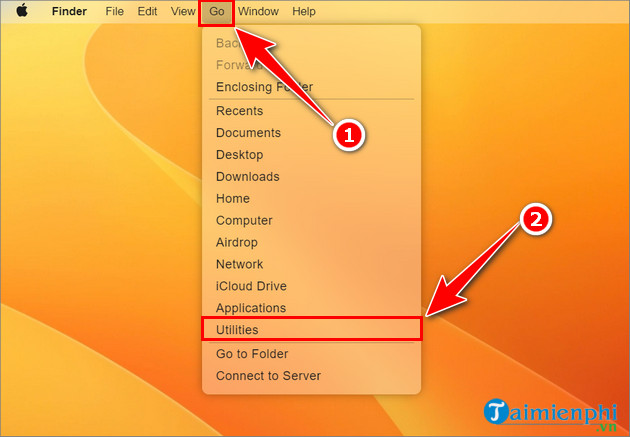
Step 2 : Select View .
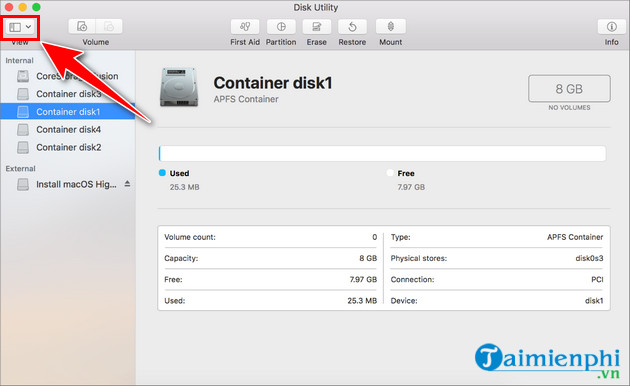
Step 3 : Select Show All Devices
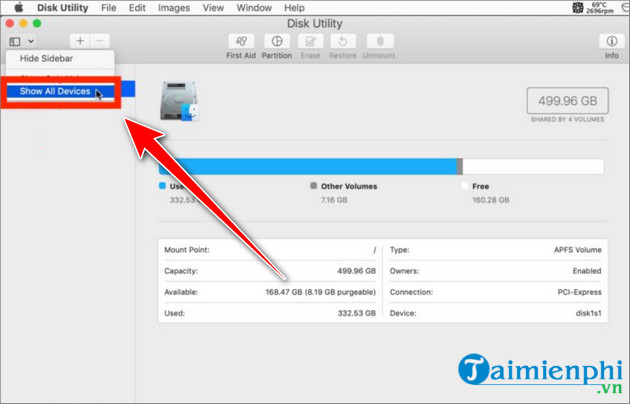
At this time, there are 3 cases that will happen:
- If the SSD has Windows NTFS format, the macOS operating system cannot write data to this hard drive. To record data, you need to install additional software.
- If the SSD has been used on another device but the Macbook cannot be recognized at this time, the file system of this SSD may not be supported or even damaged. What you need to do now is back up all data and format the hard drive.
- If it is a newly purchased SSD, it is likely that the hard drive has not been formatted. In this case, you will not see the partitions of this hard drive in the Disk Utility window, instead the message " the disk you inserted was not readable by this computer ". At this point, you need to make sure there is no data on the hard drive and use Disk Utility's erase function to reformat it.

Method 4: Use the First Aid function
If your SSD is displayed in Disk Utility, you can select that hard drive and select Mount to show this SSD in your Macbook.
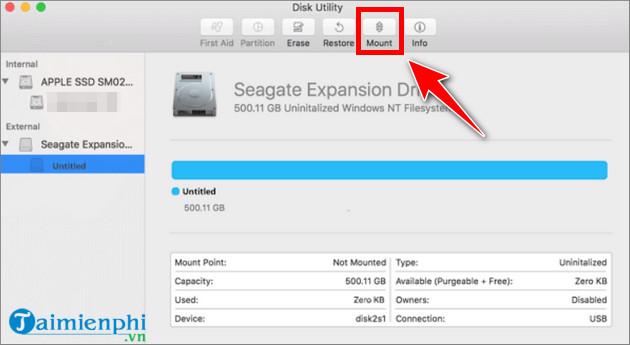
If the Mount button is dimmed, you need to use the First Aid function to fix SSD errors by selecting the hard drive to be repaired and selecting First Aid .

Method 5: Format the SSD after backing up data
If none of the above methods work, it's likely that your SSD is damaged and needs to be reformatted. However, regardless of whether the SSD error is hardware or software, your data is still the top priority.
After successfully backing up data, you can format the SSD in the following way:
Step 1 : Open Disk Utility .

Step 2 : Select the SSD to format and select Erase .

Step 3 : Fill in the necessary information and select Erase .
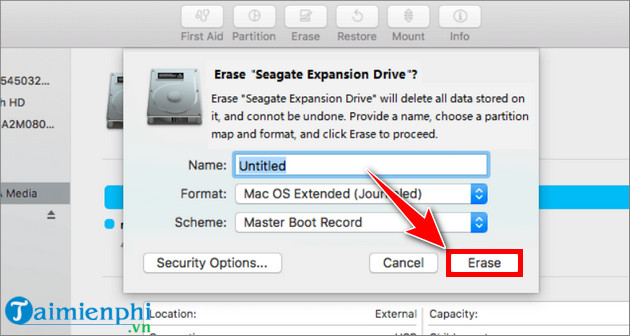
Method 6: Find a reputable technician
In case your SSD does not show up in Disk Utility , you will need to take it to a shop as only a technician can handle the hardware issue.
So, TipsMake has introduced you how to fix Macbook with SSD drive failure. Readers can also refer to other Mac tips to fix common Mac errors such as fixing Bluetooth not connecting errors, apple crash errors,.
You should read it
- How to fix automatic restart error on MacBook Pro running macOS Catalina?
- How to fix frozen MacBook error
- Apple underground replaces the MacBook Air model with Wi-Fi errors
- 8 Ways to Fix Macbook Not On Screen 100% Effectively
- Compare MacBook, MacBook Pro and MacBook Air
- How to fix Trackpad error on MacBook does not work, slow operation
- Tips to fix a white Macbook screen error
- Apple fixes the Wi-Fi connection error for MacBook Air 2013
May be interested
- How to regain access to the hard drive, fix errors that cannot open the hard drive
 in this article, we will show you how to regain access to the hard drive when it fails. let's follow it!
in this article, we will show you how to regain access to the hard drive when it fails. let's follow it! - How to scan a hard drive with Error Checking
 scanning your hard drive with the error checking tool can help identify and even repair a range of hard drive errors, from file system problems to physical problems such as bad sectors.
scanning your hard drive with the error checking tool can help identify and even repair a range of hard drive errors, from file system problems to physical problems such as bad sectors. - Instructions for choosing the best removable SSD hard drive for Macbook today
 if you need space to store data, a removable ssd hard drive for macbook is essential. choosing a hard drive will depend on many factors.
if you need space to store data, a removable ssd hard drive for macbook is essential. choosing a hard drive will depend on many factors. - 5 hard drives with the best reliability
 computer users often care about cpus and graphics cards, but hard drives are an integral part of a computer. a computer with a good gpu and cpu does not have a good ground if the hard drive is not good.
computer users often care about cpus and graphics cards, but hard drives are an integral part of a computer. a computer with a good gpu and cpu does not have a good ground if the hard drive is not good. - How to identify hard drive failure, hard drive failure, bad hard drive on Windows
 how to know the hard drive is corrupted, the hard drive is bad, bad? if your computer has the following signs, the chances are great that it already has a problem, be prepared to take it to repair or replace the new hard drive.
how to know the hard drive is corrupted, the hard drive is bad, bad? if your computer has the following signs, the chances are great that it already has a problem, be prepared to take it to repair or replace the new hard drive. - Fix hard drive not recognizing data in Windows
 why is the hard drive still recognized in windows but no data is displayed? let's find out the cause and how to fix it in the article below with hacom!
why is the hard drive still recognized in windows but no data is displayed? let's find out the cause and how to fix it in the article below with hacom! - Causes and how to fix Macbook not recognizing USB
 usb is the most popular peripheral device when using laptops and computers! the same goes for macbooks. however, many of you encounter the situation where macbook does not recognize usb. so what is the cause of this error? how to handle it?
usb is the most popular peripheral device when using laptops and computers! the same goes for macbooks. however, many of you encounter the situation where macbook does not recognize usb. so what is the cause of this error? how to handle it? - Windows 8 handles 'hard drive' error
 you will no longer be inhibited because the system is 'sluggish' every time when troubleshooting, hard drive errors like before. windows 8 handled these problems quickly and had little effect on computer performance, according to microsoft.
you will no longer be inhibited because the system is 'sluggish' every time when troubleshooting, hard drive errors like before. windows 8 handled these problems quickly and had little effect on computer performance, according to microsoft. - What is a hard drive? There are several types?
 today most types of computers are large and small need to use hard drives, this is an extremely important part for computers, it has the ability to store all personal data and they are always accessed regularly. .
today most types of computers are large and small need to use hard drives, this is an extremely important part for computers, it has the ability to store all personal data and they are always accessed regularly. . - Dissection of hard drive components
 a hard drive (commonly referred to as hard disk, hard drive, or hdd) is a non-volatile storage device that stores digital data encoded on hard disk (platter) disks quick rotation on the magnetic surface.
a hard drive (commonly referred to as hard disk, hard drive, or hdd) is a non-volatile storage device that stores digital data encoded on hard disk (platter) disks quick rotation on the magnetic surface.










 How to fix frozen MacBook error
How to fix frozen MacBook error How to fix Macbook battery error
How to fix Macbook battery error How to fix Trackpad error on Macbook Pro
How to fix Trackpad error on Macbook Pro How to install AI for MacBook
How to install AI for MacBook How to check SSD Macbook M2
How to check SSD Macbook M2 How to check the origin of Macbook M1, M2, Pro...
How to check the origin of Macbook M1, M2, Pro...